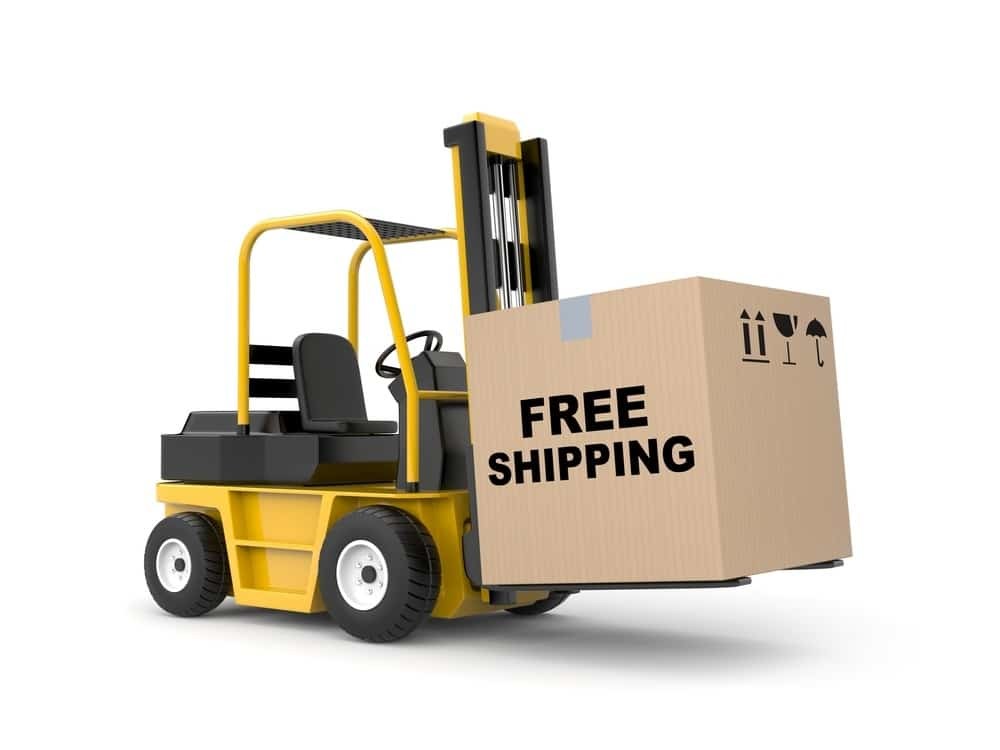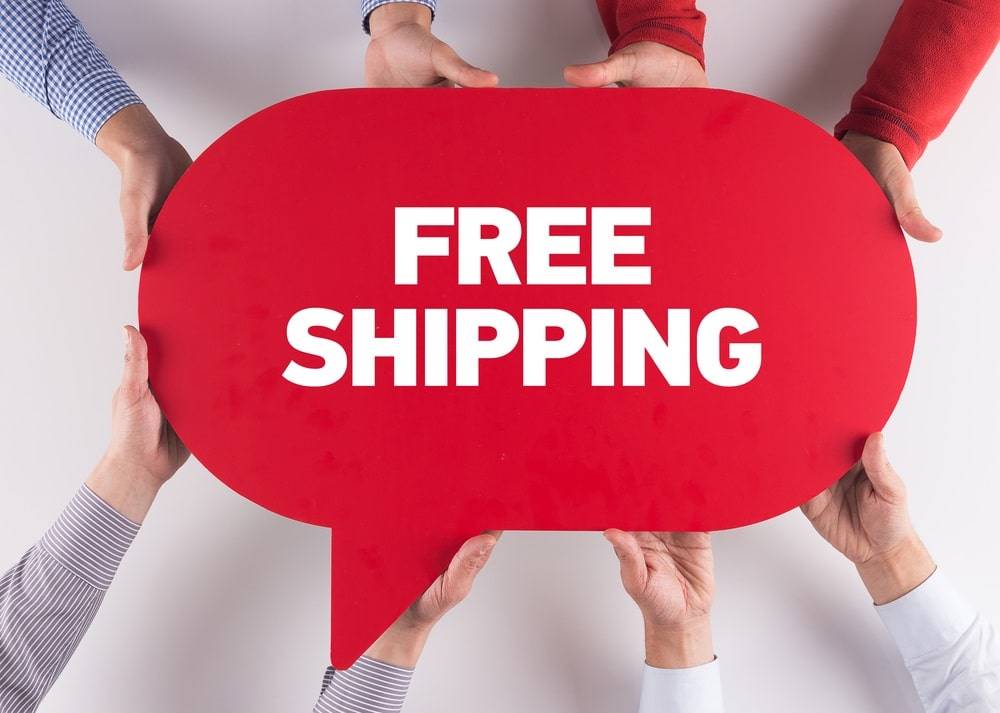There are many competitive advantages to offering ‘free shipping’ to your e-commerce customers; and if your competitors are doing it you don’t necessarily want to be the store tacking on additional fees for shoppers.
That virtually guarantees that they will buy the product elsewhere, right?
Should you offer free shipping, or look for affordable ways to reduce the delivery time for your customers using services at e-packet? Get some insights on choosing the right option for your store, and how to use free shipping as a promotional incentive that customers will love (and tell their family and friends about).
1. No-Fee Shipping Can Mean Long Delivery Delays
The average consumer wants the online good they purchased asap. Think Amazon Prime, right? Consumers are willing to pay over $150 per year for the privilege of ‘free two-day shipping’. And while that is how it is marketed to consumers as a benefit, e-commerce professionals know it is just a prepaid shipping discount service. That happens to come with some pretty cool monthly streaming video and music benefits too.
So, when you look at the average delivery times for low-cost wholesale products from AliExpress, and you see 30-days or 60-days? You can’t help but think that no online shopper on the planet is going to want to wait THAT LONG for a product. No matter how cool it is, or price discounted.
Dropified members can actually use our software to search for products from all vendors on AliExpress, including a growing number (up to 10,000) American wholesalers. You can quickly see the fulfillment and shipping information, and sort by e-packet delivery service to help shorten the delivery window for your customer to a reasonable wait.
Still not as fast as Amazon Prime right? But that’s where you provide a pricing strategy that makes your products worth the wait for customers. Learn more about e-packet delivery as a cost saving and customer service friendly option in this video on our blog.
An important thing to note, is that consumers are starting to realize that by waiting for products and bypassing that need for ‘immediate gratification’ and shipping, they can actually save a lot more money too. We have retailers like WISH to thank for that cultural shift. Ask any avid online shopper about their purchase experience with WISH, and you’ll see that product deliveries average from 4-6 weeks, depending on the item. But the price points are such a steal, consumers don’t mind the wait.
Remember that approach when pricing your own products. Use e-packet shipping where you can to shorten delivery windows for your customers. But if you can’t, remember to price your product at a discount that feels more like “an offer they can’t refuse” because it’s such an incredible bargain. Trust us; savvy shoppers are willing to wait for the right product, at the best price.
2. Creating an Average Order Value (AOV) Incentive with Free Shipping
Can you gamify your free shipping offer and help customers have a little fun, and save a lot of money buying products from your store? One of the principals of good customer service is to make the purchase decision and journey an entertaining one. If you position a qualified purchase (certain amounts of minimum order value) and tag on rewards like ‘free shipping’ or discounted product bundles, or free products? You can bet your customers will add a few extra products to their cart to qualify for the discount, and bonus rewards.
You can set that up as a consistent feature that you provide within your e-commerce sales strategy. Or you can make the AOV (average order value) incentives become limited time offers, coordinated with major shopping holidays. There is plenty of evidence that both methods help increase the per purchase value for every customer that visits your store. Experiment with both methods to see which approach works best for your brand and business model.

3. Shipping and Handling Fees Contribute to Abandoned Cart Syndrome
Be transparent about the fact that the goods available in your e-commerce store are subject to additional fees for shipping and handling. There are some good strategies to incorporate fair S&H charges that won’t impact your profit margin, or the sales revenue and appeal of the products you are selling online.
When a consumer has enjoyed the purchase experience and browsed your site and added products to the cart, they should be made aware by the time they are ready for checkout, that there will be shipping and handling charges. One of the biggest mistakes we see every day is when business owners completely hide the fact until checkout, surprising the potential customer with an extra 10% to 25% fee for shipping.
Then guess what happens? That customer is gone. Springing extra fees at the end of the sales journey is bad business and feels misleading and dishonest to consumers. It is so offensive to the majority of shoppers, that they will simply walk away from the products they were interested in buying. Worse yet, they are unlikely to return again because they feel that hidden shipping fees are bad customer service. And they are right.
There are two effective strategies to include shipping and handling charges for every product you sell, that actually solve the problem and provide a positive shopping experience for your customers. One idea is to build the price of shipping into the flat-fee list price for every product. Then the communication with your customer is simple; prices include shipping and handling.
This approach to built-in shipping and handling costs is very service friendly, and intuitive to the way we shop in a brick and mortar store. Sure, we expect to pay additional sales tax at the checkout (depending on where you live) but not additional fees that mess with the math we do, to figure out whether we are paying a good price for the goods we’re buying. Many stores adopt this model, and shoppers enjoy knowing that the price they see is the price they will pay.
The other more labor intensive (but accurate method of disclosing shipping and handling costs), is to include them within the product sales description, as a subtext below the price. Let your customer know what the cost per unit is, so that there are no surprises when it’s time for checkout.
Many experienced online shoppers understand that ordering a product from an e-commerce provider, is a convenience. They don’t have to waste that valuable time driving to more than one brick and mortar retail outlet, park, fight the crowds in the store while searching for the goods they want, and then stand in long lines of tired people to buy what they want. And for most busy people, bypassing that exhausting time sink of a process is worth paying a few extra bucks, to have their products delivered safely to their doorstep in a box.
4. Free Shipping Can Increase Sales
Some people are digital natives and have been shopping for quality goods at a bargain price online for years. These early-adopter’s and pro-level consumers are the most experienced at searching for the same product and evaluating the best deal from both Big Box stores and independent e-commerce retailers. They are not necessarily looking at the brand or culture of the online retailer but looking almost exclusively at two things; the cost of the product, and shipping and handling. That will help them decide where they will buy the product (because they know enough about e-commerce to understand that they have many different resellers to choose from).
Other consumers weigh the cost of a product they want online, against one simple factor; the added cost of shipping and handling. Sure, ordering a product online means that you are going to save time going in and out of stores looking for it, and that is a bonus. But when you tack on extra costs for shipping and handling, that advantage quickly fades into the background. Especially if the shipping and handling costs are more than the amount that the average customer feels is fair.
If you do offer free shipping, use it as a promotional angle to entice new customers to your store. It’s definitely viewed as a benefit to online shoppers, so include it in banners on your site, as subtext to your blog posts, in your sponsored advertising and on your social media profiles and cover art.
“If it’s not going to cost me anything extra, why shouldn’t I just order it online?” That is the value proposition you are creating when you incorporate free shipping into your pricing strategy.
And don’t feel trapped into offering free shipping 365 days per year. Take a page from the marketing tactics of Big Box stores, who break out ‘free shipping’ as a huge incentive right around peak holiday buying periods like Thanksgiving, Chinese New Year, Christmas, Ramadan, Easter and Valentine’s Day.
To use free shipping as an incentive, market a special limited time offer code that your shoppers can input at checkout. Why does a code work as a sales incentive? When the cart adds up the total of goods purchased, the shopper can also see the amount that they would normally pay for shipping and handling. (Don’t hide that feature! They need to see what it would have cost them without your special free shipping offer).
Seeing the cost of their purchase go down, after they have applied the special “free shipping code” is a valuable experience, that excites online shoppers. They know that they have saved money, and that promotes completed orders (lower cart abandonment at checkout) and a real sense of satisfaction for your shopper. And guess what? Shoppers love sharing bargains with their family and friends, so they are very likely to share the coupon code for free shipping. In fact, there are apps you can add to your Woocommerce and Shopify store that make it easy to create a popup of the special ‘free shipping code’ that your customers can share on Facebook or Twitter, in just a couple clicks.
Dropified members can access support and discussions between other members and e-commerce business owners on our SLACK channel, or our 60-Day Challenge Facebook Group. Ask questions, and we’ll provide some guidance and advice you can use to start experimenting with ‘free shipping’ and Average Order Value (AOV) strategies, to help you build momentum and sales volume.
To learn more about how Dropified can help your dropshipping business thrive over the coming months and years just click the button below and get started with a FREE TRIAL today!
LEARN MORE - Start Your Free Trial


